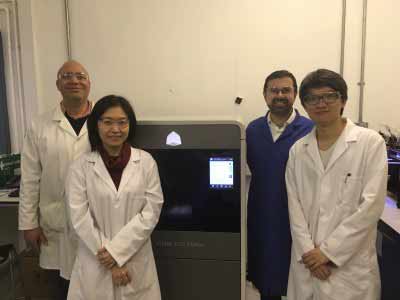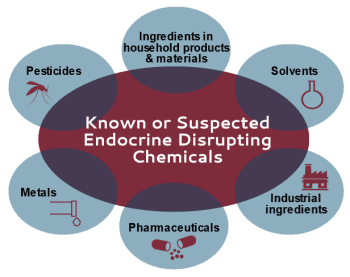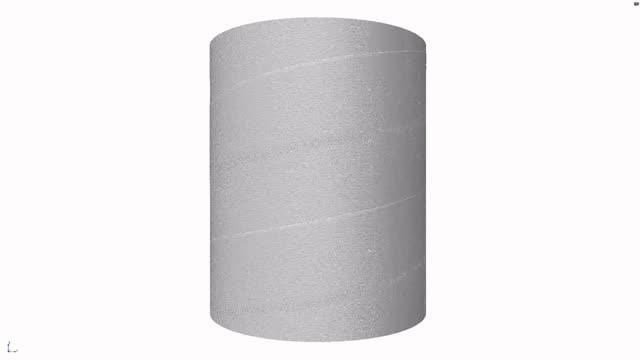
Through solar absorbers (9 panels, 5cm by 5cm in size), the team of Kyung-guen song are discussing the process of producing water at high efficiency with membrane distillation technology.
CREDIT
Korea Institue of Science and Technology(KIST)
Development of highly efficient membrane distillation process with excellent solar absorption; successful case of research that combines material technologies with water treatment technologies.
A joint research team from the Korea Institute of Science and Technology (KIST), led by Dr. Kyung-guen Song from the KIST Water Cycle Research Center and Dr. Won-jun Choi from the KIST Center for Opto-Electronic Materials and Devices, announced that it had used solar heat, a source of renewable energy, to develop a highly efficient membrane distillation technology that can produce drinking water from seawater or wastewater.
Membrane distillation is a desalination technology that turns seawater into potable water. In this process, water vapor is evaporated from seawater by thermal energy and passed through a *hydrophobic membrane, which separates the water vapor from the seawater. The water vapor then condensates to produce drinking water. Compared to existing thermal desalination methods, membrane distillation can be performed at low temperatures, which means it requires less energy, and therefore, it is receiving attention as a next-generation desalination technology. Solar-driven membrane distillation technology, in particular, has been receiving much attention, as it uses solar heat, a form of renewable energy, as its heat source, thereby helping to prevent global warming by reducing the use of fossil fuels.
*Hydrophobic membrane: A separating membrane used for distillation because of its low affinity with water, allowing only water vapor to pass through
The most important part of solar-driven membrane distillation is the solar absorber, which is used to gather solar light and heat up water. Previously commercialized solar absorbers have low solar absorption performance and can only be used in certain areas with the proper solar radiation conditions. Another weakness of preexisting systems is that their solar absorber must be very large in size in order to properly absorb the necessary amount of solar radiation.
The KIST research team applied a new solar absorber using titanium (Ti) and magnesium fluoride (MgF2) to develop a high-efficient solar driven membrane distillation technology that can exponentially increase water production.
The newly developed solar absorber absorbs over 85% of solar energy with a wavelength of 0.3-2.5 ?m, which is the main spectrum of solar energy, while being able to heat water to temperatures of more than 80°C. Furthermore, when the absorber was applied to a solar-driven membrane distillation, it was possible to produce 4.78 L/m2 of potable water over a period of 10 hours on a clear day in September. This demonstrates a very high level of performance and a production volume of more than double that of previously commercialized solar absorbers.
** Based on the annual average global insolation of Seoul ( 3.23 kWh/m2/day): An existing solar heat absorber with an area of 1m2, produced 2.14 L of water / A solar heat absorber of the same area, newly developed by the KIST, produced 4.49 L of water over the same time period.
The new solar absorber uses a multi-layer film made of titanium (Ti) metal and magnesium fluoride (MgF2) that can be simply fabricated using an electro-beam evaporator. Since the new solar absorber has excellent solar absorption performance, it is possible to apply it not only to solar-driven membrane distillation, but also to solar boilers and other apparatuses.
The solar-driven membrane distillation technology that the research team developed using the new solar absorber uses solar as its heat source. As such, the technology can be used to supply drinking water in isolated areas without energy infrastructure such as underdeveloped countries, island areas, and remote areas with a lack of potable water. The technology is also expected to be used by the military to supply drinking water to soldiers stationed abroad or at army field posts.
“This study combines material technologies with water treatment technologies and is significant in that it is a successful case of integrated research that has resulted in revolutionary achievements,” said Dr. Kyung-guen Song of the KIST. “We plan to continue developing water treatment technologies that apply advanced materials technologies through ongoing integrated research.”
The Latest Updates from Bing News & Google News
Go deeper with Bing News on:
Drinking water production
- The Benefits of Drinking Turmeric Water
Turmeric is renowned for its immune-boosting properties. It contains a compound called curcumin, which has potent anti-inflammatory and antioxidant effects. Drinking haldi water regularly can help ...
- Zinwa resumes water production at Dande River
THE Zimbabwe National Water Authority (Zinwa) has resumed water production from Dande River following cyanide spillage in late April. Zinwa head for communication and marketing, Marjorie Munyonga, ...
- Water rule needs reuse safeguards
Freshwater is an ever-scarcer resource, and our policies should encourage industry recycling of produced water instead of freshwater in the process of hydraulic fracturing or “fracking,” so that fresh ...
- What drinking lemon water daily does to your skin
Here's a closer look at what drinking lemon water daily can do for your skin: Boosts collagen production: Vitamin C plays a crucial role in collagen synthesis, which is essential for maintaining skin ...
- Q&A with Darrell King, Evanston’s water production bureau chief
In recognition of National Drinking Water Week, May 5-11, we are spotlighting Darrell King, Evanston’s water production bureau chief. Here are a few ...
Go deeper with Google Headlines on:
Drinking water production
[google_news title=”” keyword=”drinking water production” num_posts=”5″ blurb_length=”0″ show_thumb=”left”]
Go deeper with Bing News on:
Solar-driven membrane distillation technology
- Solar-powered vehicle
The solar-powered self-charging Aptera has a top speed of 100+ mph with a 0-60 mph time of 5.5 seconds. The 100 kwh battery is the highest range option for Aptera producing 1,000 miles of range.
- Technology News
the Oscar-winning “American Fiction” lands on Prime Video and “Bridgerton” returns to Netflix An unusually strong solar storm hitting Earth produced stunning displays of color in the skies ...
- Best Solar-Powered Home Security Cameras for 2024
Our team of experts at CNET has tested dozens of home security cameras, comparing indoor versus outdoor and wired versus wireless, and now even testing solar-powered security cameras to find the ...
- China Singyes Solar Technologies
China Singyes Solar Technologies Holdings Ltd. is an investment holding company. The company through its subsidiaries engages in the design, fabrication and installation of conventional curtain ...
- MAXN Maxeon Solar Technologies, Ltd.
Maxeon Solar Technologies, Ltd. designs, manufactures, markets, and sells solar panels and related solar system components worldwide. The company provides interdigitated back contact and shingled ...
Go deeper with Google Headlines on:
Solar-driven membrane distillation technology
[google_news title=”” keyword=”solar-driven membrane distillation technology” num_posts=”5″ blurb_length=”0″ show_thumb=”left”]










